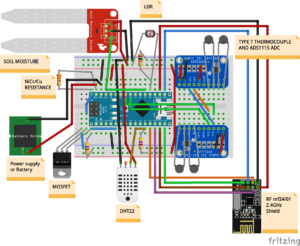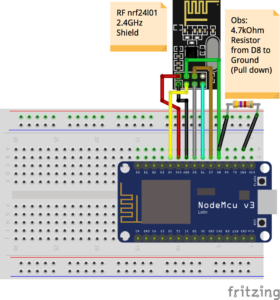This project aims at developing open source prototypes for monitoring the environment using free-design hardware and open source software. The first prototype has a sensor station and a base station. The sensor station is attached to a tree and sends the collected data to the base station, which is connected to the InterSCity Platform. The project is a partnership with the group managed by Prof. Marcos Buckeridge, from Institute of Biosciences of the University of São Paulo (IB/USP) in the context of the INCT InterSCity.
The reason for attaching the sensors to a tree is related to its importance to the environment. The health of the tree can be monitored through leaf transpiration, sap flow measurement, and environment evaluation. These methods offer indicators on the chance of a tree falling down and also the level of humidity given by the tree everyday to the cities. If one considers only the trees within a city area, it is possible to notice their important role in the ecosystem of a city due to its significant impact on reduction of air pollution, climate regulation, noise reduction, and other factors. On the other side, a tree that falls down can interrupt traffic, destroy cars, and also cause injury to a person passing by. This situation requires attention in order to take care of unhealthy trees on the streets and leverage the risk of problems.. A better discussion about this problem is presented on the article “IoTrees: Sensing the city through its trees” (in Portuguese) published at Computação Brasil Magazine n. 37, 2018.
By now, the sensor station units offer:
Instituto de Matemática e Estatística (IME) – USP
Instituto de Biociências (IB) – USP
Escola Politécnica (POLI) – USP
Institut Supérieur de l’Electronique et du Numérique (ISEN)
The stations were prototyped focusing on low-cost and open-design hardware considering that the main idea is to foster stations reproduction in large scale. The hardware used in these stations were:
Sensor station:
Base station:
A better description of the sensor station is presented in next section.
The latest hardware-design is presented below with some restrictions. The Type T thermocouple is represented by a thermistor, and the NiCr/Cu resistance is represented by a resistor due to Fritzing limitations.

Schematics for IoTrees Base Station
The idea of using an Arduino Nano over a breadboard was intentional. This approach allows other sensors to be easily attached without modifying the sensor station in most of the cases.
The first prototype was created by Anne-Camille and Oumeima during their internship at Universidade de São Paulo. The second prototype was created by Max Rosan and Victor Seiji. The latest is just an upgrade of this second one, and was made by Antonio D de Carvalho J and Max Rosan.
The Base station works as a gateway for many sensing stations. The schematic of this station is presented below:

Schematics for IoTrees Base Station